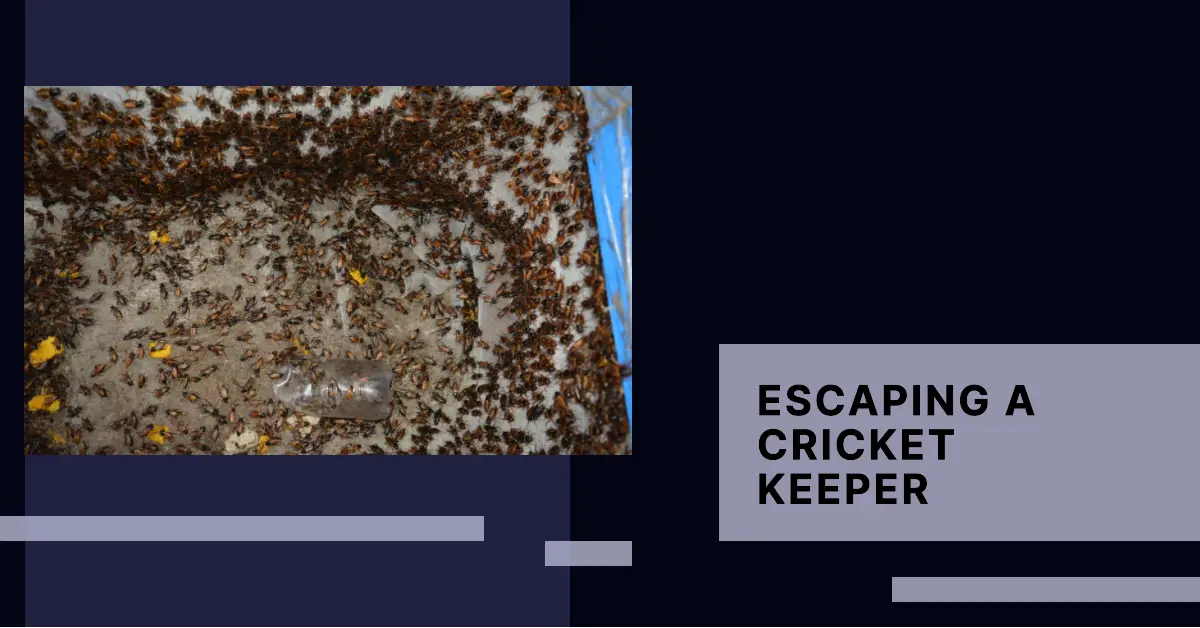
Jeffery Jago is a expert in horticulture and worm breeding. With a background in plant cultivation
Last Updated on March 27, 2023 by Jeffery Jago
Cricket keepers are essential tools for pet owners, breeders, and hobbyists who need to house and maintain live crickets as a food source for their pets or for breeding purposes.
Understanding how crickets can escape from cricket keepers is important for effectively managing these insects and minimizing potential problems.
In this article, we will explore the various ways crickets manage to get out of cricket keepers and how to prevent such escapes.

Cricket Keeper Basics
A cricket keeper is a container specifically designed to house live crickets, providing a secure and well-ventilated environment for the insects.
These containers come in various shapes, sizes, and materials, with common features such as secure lids, ventilation holes, and compartments for hiding and feeding.
When selecting a cricket keeper, it is important to consider the number of crickets you will be housing, as well as the space available in your home or facility.
Larger containers can house more crickets, but they also require more space and may be more difficult to manage.
Similarly, smaller containers may be easier to manage, but they may not provide enough space for a large colony of crickets.
Cricket Anatomy and Behaviors That Aid in Escaping
Crickets possess a number of anatomical features and behaviors that can aid in their escape from cricket keepers. Their strong hind legs are built for jumping, which enables them to leap great distances in search of an escape route.
Additionally, crickets have long, slender antennae that help them navigate and find gaps or openings in their enclosure.
Crickets also have powerful mandibles, or jaws, that can be used to bite or chew through obstacles. While they are primarily herbivores and do not typically use their jaws as a means of defense, they may resort to this tactic if they feel threatened or trapped.
With that said, It’s highly unlikely a cricket could ever chew its way out of a plastic container. Card bored on the other and is fair game.
Another behavioral adaptation that aids in their escape is their ability to hide and remain motionless for long periods of time.
Crickets have natural camouflage that allows them to blend in with their surroundings, and they may remain motionless for extended periods of time to avoid detection by predators or humans. You might have let them out yourself and not even noticed.
Crickets are also able to sense and respond to changes in their environment, such as changes in temperature, humidity, or air flow. This allows them to detect potential escape routes and take advantage of them when they become available.
Overall, the combination of strong jumping legs, long antennae for navigation, powerful mandibles for chewing through obstacles, and the ability to hide and remain motionless make crickets adept at escaping from cricket keepers and other enclosures.
It is important for cricket keepers to be aware of these behaviors and take steps to prevent escapes, such as providing secure enclosures with tight-fitting lids and regularly checking for gaps or openings.
Common Ways Crickets Escape from Cricket Keepers
There are several ways that crickets can manage to escape from their cricket keepers:
- Inadequate lid or ventilation hole security: Crickets may exploit gaps or weak points in the lid or ventilation holes to squeeze through and escape.
- Weaknesses in the cricket keeper structure: Cracks, seams, or other structural weaknesses can provide crickets with an escape route.
- Cricket keepers placed near objects that facilitate escape: If a cricket keeper is placed near objects like furniture, crickets may use these items as a springboard for their escape.
- Human error in handling or maintaining the cricket keeper: Accidentally leaving the lid open or not properly securing it can provide crickets with an easy escape opportunity.
In addition to these common ways crickets can escape from cricket keepers, there are other factors that may contribute to escape. For example:
- Overcrowding: If the cricket keeper is overcrowded, crickets may become restless and agitated, leading them to search for a way out.
- Inadequate hiding places: Without adequate hiding places in the cricket keeper, crickets may feel exposed and vulnerable, making them more likely to attempt to escape.
- Inadequate food or water: If crickets do not have access to adequate food or water, they may become more active and desperate in their attempts to escape.
- Stress: Stress can also play a role in cricket escape attempts. If crickets are subjected to loud noises, vibrations, or other stressful conditions, they may become more agitated and motivated to escape.
Overall, preventing cricket escape requires careful attention to detail and regular maintenance of the cricket keeper.
This includes ensuring that the lid and ventilation holes are securely fastened, providing adequate hiding places, food, and water, and minimizing sources of stress or overcrowding.
By taking these steps, cricket keepers can help prevent escapes and keep their crickets secure and healthy.
Tips for Preventing Crickets from Escaping Cricket Keepers
To minimize the chances of crickets escaping from their keepers, consider the following tips:
- Ensure proper lid and ventilation hole security: Make sure the lid and any ventilation holes are securely fastened and that there are no gaps or weak points that crickets can exploit.
- Regularly inspect and maintain the cricket keeper structure: Check for cracks, seams, or other potential weaknesses and repair or replace the cricket keeper as needed.
- Proper placement and handling of the cricket keeper: Keep the cricket keeper away from objects that could facilitate escape and handle it carefully to avoid creating opportunities for crickets to flee.
- Provide adequate hiding places: Add cardboard tubes, egg cartons, or other hiding places to give crickets a sense of security and prevent them from becoming restless or agitated.
- Regularly clean and maintain the cricket keeper: Clean the cricket keeper regularly to remove uneaten food, waste, and other debris that can build up and create a conducive environment for crickets to escape.
- Monitor food and water levels: Make sure crickets have access to adequate food and water, as hunger or thirst can lead them to become more active and motivated to escape.
- Minimize sources of stress: Avoid loud noises, vibrations, or other stressful conditions that can cause crickets to become agitated and more likely to try to escape.
The Importance of Proper Cricket Keeper Management
Preventing cricket escapes is not only beneficial for pet owners and breeders but also has ecological and pest management implications.
Escaped crickets can become pests in some environments and may disrupt local ecosystems if they are not native to the area.
By managing cricket keepers effectively, you can minimize the risks associated with escaped crickets and ensure a more controlled and efficient process for maintaining your insect population.
It is important to be cautious when using escaped crickets to feed animals, as these insects may have been exposed to parasites and contaminants outside of their sterile cricket keeper environment.
Once crickets have escaped, they may come into contact with pathogens, pesticides, or other harmful substances that can pose a risk to the health of animals that consume them.
In addition, crickets that have been exposed to these substances may also accumulate toxins in their bodies, which can be harmful to animals that consume them.
This can be particularly problematic if the crickets are being used as a primary source of nutrition for the animals.
To avoid these risks, it is best to use only crickets that have been purchased from a reputable supplier and kept in a clean, controlled environment.
If crickets do escape from their keeper, it is important to not use them as feed for animals, but rather to capture and dispose of them properly.
Conclusion
Understanding how crickets can escape from cricket keepers and taking appropriate preventive measures are essential aspects of proper cricket keeper management.
By ensuring secure lids, ventilation, and proper handling, you can minimize the chances of crickets escaping and maintain a controlled environment for these fascinating insects.
With the right approach, you can effectively house and manage your cricket population while minimizing the potential impact on your surroundings and the local ecosystem.

